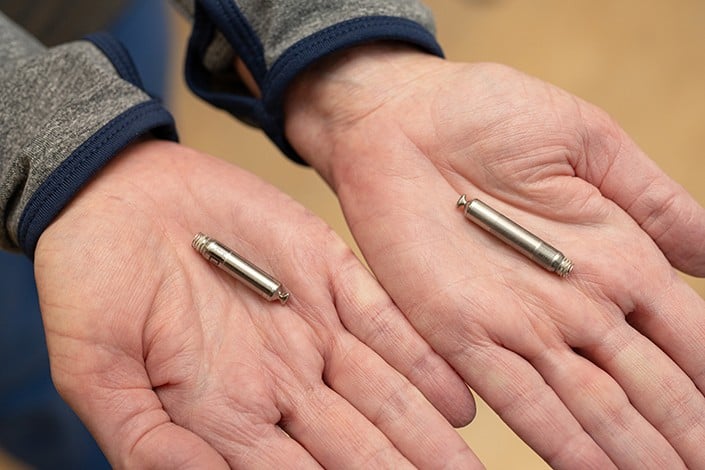
UC San Diego Health is the first in San Diego to successfully implant the world’s first dual chamber and leadless pacemaker system to help treat people with abnormal heart rhythms. Holding the device and pictured above is Ulrika Birgersdotter-Green, MD, cardiologist and director of pacemaker and ICD services at UC San Diego Health. Credit: Kyle Dykes / UC San Diego Health
March 26, 2024 — UC San Diego Health is the first health system in San Diego to successfully implant the world’s first dual chamber and leadless pacemaker system to help treat people with irregular heart rhythms, known as arrhythmias, which can lead to complications like palpitations, fainting and stroke.
The most common arrhythmia, atrial fibrillation, will affect approximately 12.1 million people in the United States by 2030, based on an estimation from the Centers for Disease Control and Prevention. Pacemakers and implantable cardioverter defibrillators (ICDs) are the standard of care to regulate a patient’s irregular heartbeat.
Approved by the U.S. Food and Drug Administration (FDA) in July 2023, a new leadless pacemaker system placed in both chambers of the heart and using a novel communication technology is now offering a more minimally invasive option for patients.
UC San Diego Health implanted the pacemaker system in the first patient in February 2024.
“To have the option to use a leadless pacemaker system on both sides of the heart will allow us to treat more individuals currently living with heart arrhythmias,” said Ulrika Birgersdotter-Green, MD, cardiologist and director of pacemaker and ICD services at UC San Diego Health.

The new system, approximately one-tenth the size of a traditional pacemaker, is comprised of two devices: one in the atrium, or top right heart chamber, and one in the ventricle, bottom right chamber. Credit: Kyle Dykes / UC San Diego Health
Nearly 80% of patients who receive a pacemaker need a dual chamber option. Although leadless pacemakers have been the preferred option for patients, historically they have only been available for individuals who require pacing on one side of the heart.
“The new system is comprised of two devices — one in the atrium, or top right heart chamber, and one in the ventricle, bottom right chamber,” said Green. “The two devices then communicate with one another through the heart's natural circulatory system that controls the heartbeat."
Traditional pacemakers and ICDs require leads, or thin wires, that conduct electrical signals inside the heart and blood vessels of patients. The leads are attached to a battery-powered generator that is commonly implanted beneath the skin, below the collarbone. The burst of energy can cause the heart to beat more quickly (in a pacemaker), or it can stop dangerous rapid heart rhythms (in an ICD).
The new system, the size of a AAA battery, does not require a surgical “pocket’ under the skin as it is leadless and does not have a generator, but rather is small enough to be delivered through a catheter and implanted directly into the heart, making it a more minimally invasive approach for patients.
“Leadless pacemakers are considered the future in the treatment of heart arrhythmias and have allowed many patients to live their lives with no visible evidence of a pacemaker or heart device," said Birgersdotter-Green.
The procedure is performed in the region’s first hybrid, state-of-the-art operating room at Sulpizio Cardiovascular Center at UC San Diego Health. The pacemaker system can be removed or replaced at any time should a person’s treatment requirements change.
“This advancement for our patients needing cardiovascular care is the result of our extraordinary multidisciplinary, electrophysiology team at UC San Diego Health,” added Birgersdotter-Green.
UC San Diego Health’s board-certified electrophysiologists perform among the largest volumes of device implantations, heart ablations and laser lead extractions in the nation, offering advanced remote monitoring for devices using minimally invasive surgical techniques.
For more information: https://health.ucsd.edu/


 April 29, 2025
April 29, 2025 









